- Home
- Mobiles
- Mobiles Reviews
- Gionee Elife E6 review
Gionee Elife E6 review
By Anupam Saxena | Updated: 27 November 2013 18:59 IST
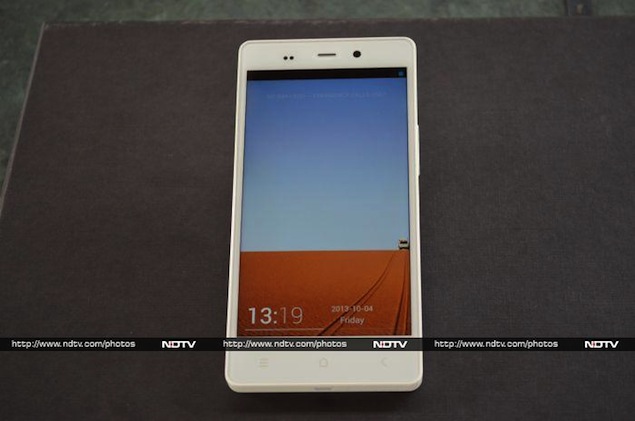
Advertisement
It hasn't been long since Chinese device maker Gionee set foot in the Indian market, and the company seems to have generated some buzz in this period, taking on Indian device makers like Micromax, Karbonn and Xolo with its budget smartphones, offering decent hardware specifications at an economy price.
The Gionee Elife E6 is the company's latest flagship phone. The phone got our attention with its sleek unibody form factor and clean lines, not usually seen in mid-range smartphones.
The Elife E6 boasts of a full-HD screen, which is one of its major USPs, with only a handful of phones in the same price range that offer a 1080p display.
Is the Gionee Elife E6 the best Android smartphone in its class? We find out in our detailed re review.
Build / Design
The Gionee Elife E6 features a premium unibody design with a polycarbonate build that can be compared to the likes of the Nokia Lumia phones. It also borrows some elements from the iPhone 5's design, with a similar rectangular slab and rounded corners form factor. Even the positioning of the camera lens, the speaker grill and the Micro-USB port is similar to that of the iPhone 5 / 5s (the iPhone has a lightning connector port at the same place, though).
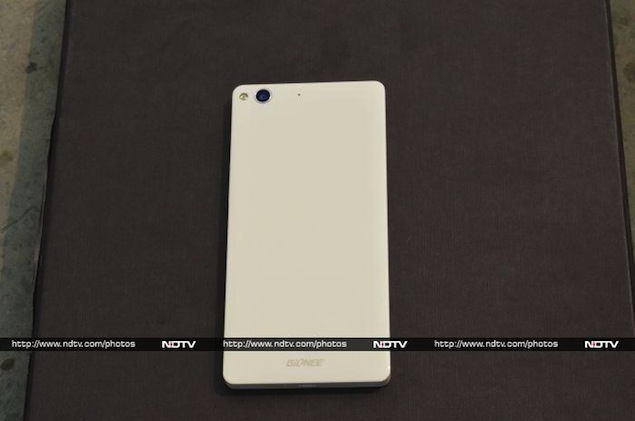 We had a White colour variant of the Gionee Elife E6 as our review unit, although the phone also comes in a Black colour variant. The phone's body (excluding the front) sports a glossy, enamel like finish and can be slippery at times, owing to the phone's large form factor.
We had a White colour variant of the Gionee Elife E6 as our review unit, although the phone also comes in a Black colour variant. The phone's body (excluding the front) sports a glossy, enamel like finish and can be slippery at times, owing to the phone's large form factor.
The front of the Elife E6 features a 5-inch IPS Full-HD display, with the sensor array, a 5-megapixel front-facing camera lens and a notification LED are located above it. The three capacitive touch buttons, namely the Menu, Home and Back key, are located below the display.
The side edges of the Gionee Elife E6 are not rounded, and are relatively sharp. The volume rocker key is located at the right edge, while the micro-SIM tray is located at the left edge. The power / screen lock key sits at the top, with the 3.5mm headset jack and the Micro-USB port is placed at the bottom edge with the two speaker grills. The hardware buttons are metallic, and offer decent tactile feedback.
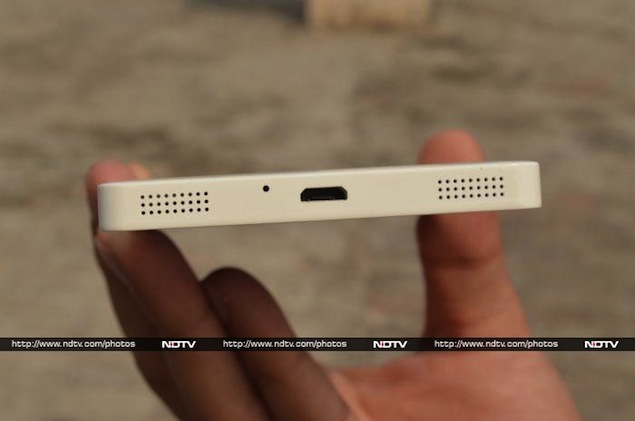 The back of the phone sports minimal branding towards the bottom, with the 13-megapixel camera lens and LED flash located toward the top left corner. The glossy finish of the back makes the Gionee Elife E6 prone to smudges.
The back of the phone sports minimal branding towards the bottom, with the 13-megapixel camera lens and LED flash located toward the top left corner. The glossy finish of the back makes the Gionee Elife E6 prone to smudges.
The phone is not very bulky and fits easily into your pocket. Overall, the Gionee Elife E6 is a looker, and except for the glossy finish that makes it a bit slippery and prone to smudges, we don't have any qualms with it in this department.
Display
The Gionee Elife E6 features a 5-inch full-HD (1080x1920 pixels resolution) IPS screen based on One Glass Solution (OGS) technology with a Gorilla Glass 3 layer for protection. The screen is bright and vibrant, with text and images looking extremely crisp and sharp. However, colours appeared to be oversaturated, almost at AMOLED levels.
Sunlight legibility was decent, and viewing angles were excellent thanks to the IPS panel. Overall, the Gionee Elife E6 has one of the best displays in its class only marred by its inaccurate colour rendering.
Software / User Interface
The Gionee Elife E6 runs a highly-tweaked version of Android 4.2.1 Jelly Bean. The handset maker has put a custom 'Amigo' skin on top of the UI, and offers themes that let the user customise the phone's home screen and app icons.
In fact, if you remove the Google services and the Play store, and it would look like a different operating system, similar to Xiaomi's MiUi interface which is based on Android. The phone's OS doesn't offer the traditional Android home screen - app launcher structure, but instead, is a little similar to the iPhone's layout - the Elife E6's home screen is also the app launcher
For users who're switching to the Elife E6 from another Android phone, the arrangement would be a little unsettling but otherwise it might not be much of a problem.
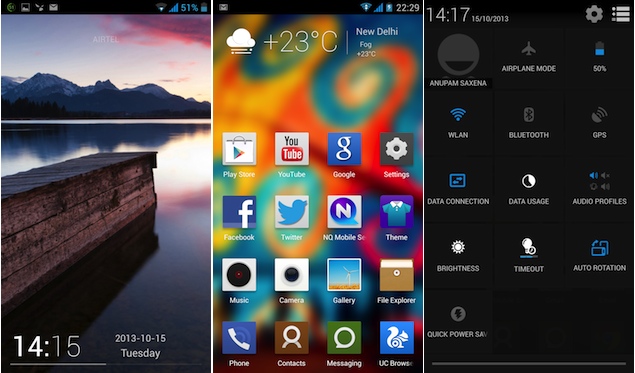 Users can add up to nine home screens, which can be populated with app icons. The Gionee Elife E6 doesn't support widgets, though a weather and time widget stays on top of each of the phone's home-screen. It's also displayed on the lock screen, in addition to another lock-screen widget that offers shortcuts to the camera, torch and sound recorder apps.
Users can add up to nine home screens, which can be populated with app icons. The Gionee Elife E6 doesn't support widgets, though a weather and time widget stays on top of each of the phone's home-screen. It's also displayed on the lock screen, in addition to another lock-screen widget that offers shortcuts to the camera, torch and sound recorder apps.
The notification tray on the Elife E6 features a settings shortcut and a clear all notifications button, along with expandable notifications (expanded with the two finger pull gesture). It features the same setting toggles shortcuts (plus a few extra) that are found in stock Android for quick access to airplane mode, battery status, Wi-Fi, Bluetooth, GPS, data connection, data usage, audio profiles, brightness, screen backlight timeout, auto rotation, power saving mode and alarm clock.
The option to wirelessly mirror the Elife E6's display with an HDMI-enabled device through a wireless display adapter is also present. This is essentially an Android 4.2 feature.
There's a dock at the bottom if the Gionee Elife E6's interface, where four preferred app shortcuts can be placed. This dock is static across all the home screens. Each home screen can have 12 app icons in addition to the dock.
The lock screen mechanism is also a little different on the Gionee Elife E6. You can either just press the power button to lock the screen or swipe towards the bottom of the screen from the weather+time widget. Swiping up unlocks the screen.
The Gionee Elife E6's UI is full of transition animations and effects and you can even customise some of them. When you tap an app icon, the app pops up from the bottom of the screen. When you exit the app the app window retracts to the bottom again. These effects look gimmicky and jarring, and increase the launch time of apps.
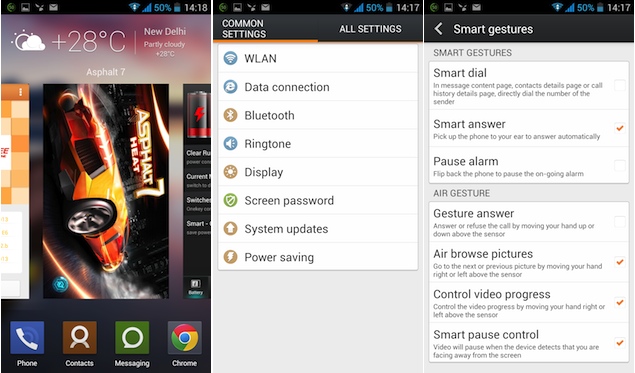 The Gionee Elife E6's UI borrows its app switcher from Apple's iOS 7 card-based multitasking menu, which was first seen in webOS and later in BlackBerry PlayBook OS. The implementation is almost the same with a full window preview of the running apps being displayed as soon as the Home button is pressed. You can dismiss apps by throwing their preview windows out of the screen and switch by swiping horizontally.
The Gionee Elife E6's UI borrows its app switcher from Apple's iOS 7 card-based multitasking menu, which was first seen in webOS and later in BlackBerry PlayBook OS. The implementation is almost the same with a full window preview of the running apps being displayed as soon as the Home button is pressed. You can dismiss apps by throwing their preview windows out of the screen and switch by swiping horizontally.
We feel that pressing the home button on the Gionee Elife E6 should take users to the first home screen and not open the app switcher. At times, pressing the home button when you're in a system app (messaging, gallery) also opens the app switcher instead of taking you to the home screen/ launcher.
The three capacitive buttons, back, home and menu, help in navigating through the Gionee Elife E6, with the home button also doubling up as an app switcher/ task manager on long press.
The settings menu of the Gionee Elife E6 offers popular settings under the 'common settings' tab and hides the complete set of settings under the 'all' tab. This makes things simple for new smartphone users but increases a step for people familiar with the default Android settings menu.
The phone also includes 'smart gestures' and 'air gestures'. The smart gestures include smart dial (dial a number displayed in a message, contact details page when you bring the phone close to your ear), smart answer (answer the phone automatically when you bring the phone close to your ear), and pause alarm (when you flip the phone). These worked as promise.
The Elife E6 also offers air gestures, as seen in phones like the Samsung Galaxy S4 and even in some economy phones such as the Lava Iris 504. The feature enables users to answer calls or browse pictures by just waving your hand. This didn't work for us at all. The only gesture that worked was the 'smart pause' control that pauses the video when you look away.
Gionee has also bundled some apps with the Elife E6, including UC Browser - the phone's default web browser, File Explorer, Facebook, Twitter, NQ Mobile Security, WhatsApp, Yahoo Cricket, GameZone - a games store to download new games, Fishing Joy game, WeChat, Notes, App Manager, a torch app (to use the LED flash as a flash light), a compass app, Kingsoft Office, a weather app, as well as the GioneeXender app - for transferring content, Du Battery Saver app, and Saavn - the Indian music streaming service.
Some of the native apps on the Elife E6 offer extended functionality. For instance, the Music app allows you to put a sleep timer, if you like falling asleep while listening to music. The phone dialler allows you to record voice calls. Most Android phones don't offer this feature though this functionality is offered by some third-party apps that have certain limitations and don't offer good quality recordings. The phone also allows you to set a sleep timer to turn the phone off/ on or in airplane mode.
Overall, the Elife E6's UI could do with some more finishing touches. We hope Gionee pushes an update to fix minor niggles.
Camera
The Gionee Elife E6 sports a 13-megapixel auto-focus camera with a Sony Exmor R sensor and five element lens. It also includes a second generation BSI sensor for low-light imaging.
The phone comes with a customised Camera app and allows you to capture photos in HDR and Panorama modes as well. It comes with the usual controls including settings for Exposure, Colour effect, White balance and ISO, among others.
 The Elife E6's camera also supports continuous shots, taking up to 99 shots in that mode, apart from supporting smile detection and face detection. It also comes with a 'Phone Booth' setting that lets you superimpose fancy picture frames with photos. In addition to this it also features colour effects or filters.
The Elife E6's camera also supports continuous shots, taking up to 99 shots in that mode, apart from supporting smile detection and face detection. It also comes with a 'Phone Booth' setting that lets you superimpose fancy picture frames with photos. In addition to this it also features colour effects or filters.
The camera of the Gionee Elife E6 takes good quality images in daylight and in sufficient artificial light. However, we observed that pictures taken in low-light conditions did not come out well.
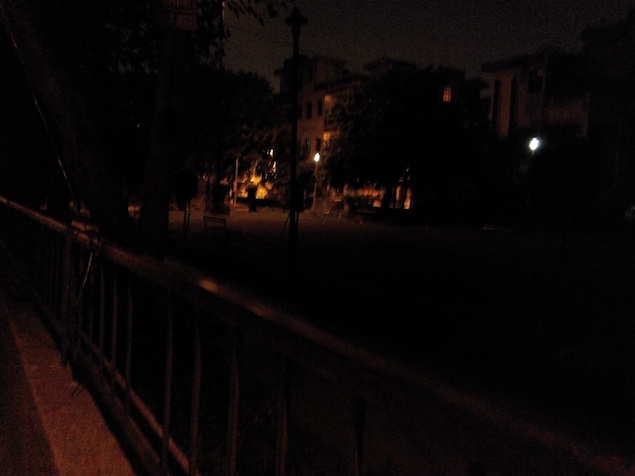 Pictures taken indoors with less light were also grainy. Colour reproduction was pretty accurate and images sported good contrast, though it did miss out on detail at times.
Pictures taken indoors with less light were also grainy. Colour reproduction was pretty accurate and images sported good contrast, though it did miss out on detail at times.
 The Elife E6 can record HD videos and we found that the quality of videos captured through the back camera was good. It also offers EIS or Electronic Image Stabilisation to minimise blurring caused by shaking of hands while shooting a video.
The Elife E6 can record HD videos and we found that the quality of videos captured through the back camera was good. It also offers EIS or Electronic Image Stabilisation to minimise blurring caused by shaking of hands while shooting a video.
The 5-megapixel front camera also takes decent shots and is great for video calls. Overall, we feel that the Elife E6 can fill in for a point and shoot camera barring low-light conditions.
Performance
The Gionee Elife E6 is powered by a 1.5GHz Mediatek MT6589T quad-core processor. It has 2GB RAM, and a PowerVR SGX 544MP GPU. The phone offers 32GB of internal storage, which is non-expandable, and around 23GB of storage is available to the user. We wish the phone would have come with a microSD card slot keeping in consideration that some users like to store movies and music on their phones.
The overall experience of navigation through the Elife E6's interface was impressive, thanks to the phone's quad-core processor and sufficient memory, though the additional visual effects do make slow things down slightly.
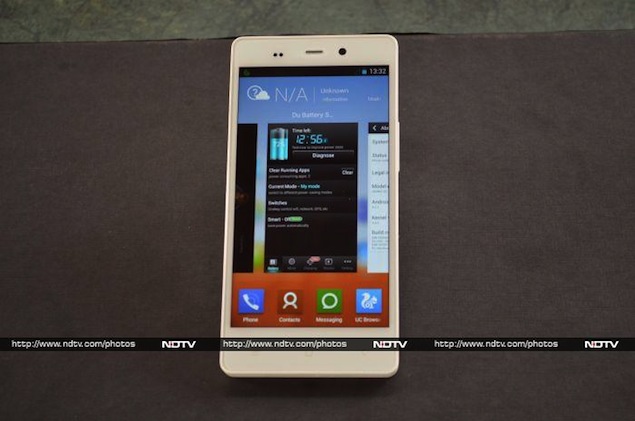 We did not experience any lag while launching apps, playing most games, scrolling web pages or switching between apps. Graphics intensive games however, like Asphalt 7: Heat, did slow down the Gionee Elife E6 substantially, with visibly dropped frame rates.
We did not experience any lag while launching apps, playing most games, scrolling web pages or switching between apps. Graphics intensive games however, like Asphalt 7: Heat, did slow down the Gionee Elife E6 substantially, with visibly dropped frame rates.
We were able to play full-HD clips smoothly and the Elife E6 supported formats like .AVI and .MOV, natively. The speaker on the phone delivers decent quality sound at above good volume levels, and thanks to the location of the speaker grill, the sound doesn't get muffled when the phone lies on its back.
The headphones that come with the Gionee Elife E6 offer good quality sound output, and look good in white and silver colour. The phone also offers FM radio and recording. Call quality was good. The Elife E6 was also able to get a GPS lock easily while using the Maps app.
The Gionee Elife E6 comes with an 2,000mAh battery, and based on our experience, it will last you more than a full day with medium to heavy usage, including 1 to 1.5 hours of phone calls, two e-mail accounts with push notifications, screen at maximum brightness, playing some music and video clips, Twitter notifications and WhatsApp chats.
It's also worth pointing out that we had majorly used mobile data, occasionally connecting to Wi-Fi and had turned off auto-brightness - instead, keeping it at full brightness. The phone was hooked to a 3G network for most of the time. Altering these settings might help in running the Elife E6 for a longer duration, depending on your usage pattern.
Gionee also offers a 'power saving' mode that limits processor utilization, and turns off data sync and various connectivity options when the phone's screen is locked for five minutes. You might be able to get some extra hours with this setting at the expense of the phone's functionality.
Verdict
Interestingly, Gionee takes on Indian brands like Micromax and Karbonn that also import Chinese devices and rebrand them. Of course, it still needs to make its presence felt in the market but in our use, we found the the Elife E6 to be much better than what Indian smartphone brands offer in terms of build and design, display and other features.
It even challenges the A-list brands like Sony, Samsung and HTC, that don't really offer a viable option in the Rs. 20,000 to Rs. 25,000 price segment, unless you are ready to settle with older generation devices. Sony's Xperia C, HTC's Desire 500, Samsung's Galaxy Grand Quattro are the only devices from major manufacturers that offer quad-core smartphones in the same price segment, though none are clocked at 1.5GHz, feature 2GB of RAM, or a 5-inch FHD display.
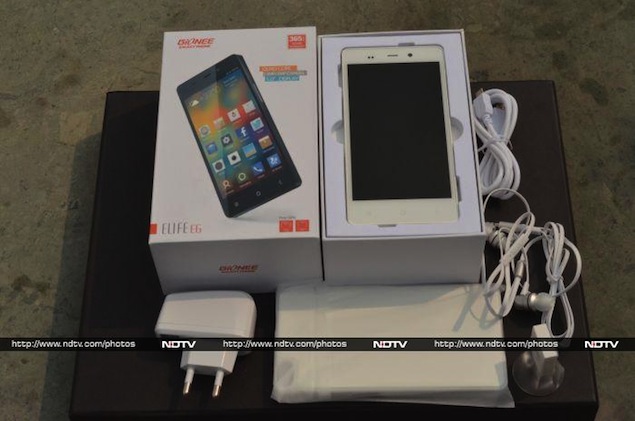 The only issue we're concerned about is after sales service from Gionee. Although the company appears to have set up service centres at all major locations in India, one can't deny that it's a new player in a market. If you don't take these factors into consideration, the Gionee Elife E6 is definitely a good buy at a price of Rs. 22,999.
The only issue we're concerned about is after sales service from Gionee. Although the company appears to have set up service centres at all major locations in India, one can't deny that it's a new player in a market. If you don't take these factors into consideration, the Gionee Elife E6 is definitely a good buy at a price of Rs. 22,999.
You can also look at the Lenovo K900 (also full-HD), Nexus 4 and Huawei Ascend Mate that also fall in the same price segment. If you're open to Windows Phone, then the Nokia Lumia 720 is also a good option, though it has a smaller screen.
Price: Rs. 22,999

Gionee Elife E6 in pictures
The Gionee Elife E6 is the company's latest flagship phone. The phone got our attention with its sleek unibody form factor and clean lines, not usually seen in mid-range smartphones.
The Elife E6 boasts of a full-HD screen, which is one of its major USPs, with only a handful of phones in the same price range that offer a 1080p display.
Is the Gionee Elife E6 the best Android smartphone in its class? We find out in our detailed re review.
Build / Design
The Gionee Elife E6 features a premium unibody design with a polycarbonate build that can be compared to the likes of the Nokia Lumia phones. It also borrows some elements from the iPhone 5's design, with a similar rectangular slab and rounded corners form factor. Even the positioning of the camera lens, the speaker grill and the Micro-USB port is similar to that of the iPhone 5 / 5s (the iPhone has a lightning connector port at the same place, though).
The front of the Elife E6 features a 5-inch IPS Full-HD display, with the sensor array, a 5-megapixel front-facing camera lens and a notification LED are located above it. The three capacitive touch buttons, namely the Menu, Home and Back key, are located below the display.
The side edges of the Gionee Elife E6 are not rounded, and are relatively sharp. The volume rocker key is located at the right edge, while the micro-SIM tray is located at the left edge. The power / screen lock key sits at the top, with the 3.5mm headset jack and the Micro-USB port is placed at the bottom edge with the two speaker grills. The hardware buttons are metallic, and offer decent tactile feedback.
The phone is not very bulky and fits easily into your pocket. Overall, the Gionee Elife E6 is a looker, and except for the glossy finish that makes it a bit slippery and prone to smudges, we don't have any qualms with it in this department.
Display
The Gionee Elife E6 features a 5-inch full-HD (1080x1920 pixels resolution) IPS screen based on One Glass Solution (OGS) technology with a Gorilla Glass 3 layer for protection. The screen is bright and vibrant, with text and images looking extremely crisp and sharp. However, colours appeared to be oversaturated, almost at AMOLED levels.
Sunlight legibility was decent, and viewing angles were excellent thanks to the IPS panel. Overall, the Gionee Elife E6 has one of the best displays in its class only marred by its inaccurate colour rendering.
Software / User Interface
The Gionee Elife E6 runs a highly-tweaked version of Android 4.2.1 Jelly Bean. The handset maker has put a custom 'Amigo' skin on top of the UI, and offers themes that let the user customise the phone's home screen and app icons.
In fact, if you remove the Google services and the Play store, and it would look like a different operating system, similar to Xiaomi's MiUi interface which is based on Android. The phone's OS doesn't offer the traditional Android home screen - app launcher structure, but instead, is a little similar to the iPhone's layout - the Elife E6's home screen is also the app launcher
For users who're switching to the Elife E6 from another Android phone, the arrangement would be a little unsettling but otherwise it might not be much of a problem.
The notification tray on the Elife E6 features a settings shortcut and a clear all notifications button, along with expandable notifications (expanded with the two finger pull gesture). It features the same setting toggles shortcuts (plus a few extra) that are found in stock Android for quick access to airplane mode, battery status, Wi-Fi, Bluetooth, GPS, data connection, data usage, audio profiles, brightness, screen backlight timeout, auto rotation, power saving mode and alarm clock.
The option to wirelessly mirror the Elife E6's display with an HDMI-enabled device through a wireless display adapter is also present. This is essentially an Android 4.2 feature.
There's a dock at the bottom if the Gionee Elife E6's interface, where four preferred app shortcuts can be placed. This dock is static across all the home screens. Each home screen can have 12 app icons in addition to the dock.
The lock screen mechanism is also a little different on the Gionee Elife E6. You can either just press the power button to lock the screen or swipe towards the bottom of the screen from the weather+time widget. Swiping up unlocks the screen.
The Gionee Elife E6's UI is full of transition animations and effects and you can even customise some of them. When you tap an app icon, the app pops up from the bottom of the screen. When you exit the app the app window retracts to the bottom again. These effects look gimmicky and jarring, and increase the launch time of apps.
We feel that pressing the home button on the Gionee Elife E6 should take users to the first home screen and not open the app switcher. At times, pressing the home button when you're in a system app (messaging, gallery) also opens the app switcher instead of taking you to the home screen/ launcher.
The three capacitive buttons, back, home and menu, help in navigating through the Gionee Elife E6, with the home button also doubling up as an app switcher/ task manager on long press.
The settings menu of the Gionee Elife E6 offers popular settings under the 'common settings' tab and hides the complete set of settings under the 'all' tab. This makes things simple for new smartphone users but increases a step for people familiar with the default Android settings menu.
The phone also includes 'smart gestures' and 'air gestures'. The smart gestures include smart dial (dial a number displayed in a message, contact details page when you bring the phone close to your ear), smart answer (answer the phone automatically when you bring the phone close to your ear), and pause alarm (when you flip the phone). These worked as promise.
The Elife E6 also offers air gestures, as seen in phones like the Samsung Galaxy S4 and even in some economy phones such as the Lava Iris 504. The feature enables users to answer calls or browse pictures by just waving your hand. This didn't work for us at all. The only gesture that worked was the 'smart pause' control that pauses the video when you look away.
Gionee has also bundled some apps with the Elife E6, including UC Browser - the phone's default web browser, File Explorer, Facebook, Twitter, NQ Mobile Security, WhatsApp, Yahoo Cricket, GameZone - a games store to download new games, Fishing Joy game, WeChat, Notes, App Manager, a torch app (to use the LED flash as a flash light), a compass app, Kingsoft Office, a weather app, as well as the GioneeXender app - for transferring content, Du Battery Saver app, and Saavn - the Indian music streaming service.
Some of the native apps on the Elife E6 offer extended functionality. For instance, the Music app allows you to put a sleep timer, if you like falling asleep while listening to music. The phone dialler allows you to record voice calls. Most Android phones don't offer this feature though this functionality is offered by some third-party apps that have certain limitations and don't offer good quality recordings. The phone also allows you to set a sleep timer to turn the phone off/ on or in airplane mode.
Overall, the Elife E6's UI could do with some more finishing touches. We hope Gionee pushes an update to fix minor niggles.
Camera
The Gionee Elife E6 sports a 13-megapixel auto-focus camera with a Sony Exmor R sensor and five element lens. It also includes a second generation BSI sensor for low-light imaging.
The phone comes with a customised Camera app and allows you to capture photos in HDR and Panorama modes as well. It comes with the usual controls including settings for Exposure, Colour effect, White balance and ISO, among others.
The camera of the Gionee Elife E6 takes good quality images in daylight and in sufficient artificial light. However, we observed that pictures taken in low-light conditions did not come out well.
The 5-megapixel front camera also takes decent shots and is great for video calls. Overall, we feel that the Elife E6 can fill in for a point and shoot camera barring low-light conditions.
Performance
The Gionee Elife E6 is powered by a 1.5GHz Mediatek MT6589T quad-core processor. It has 2GB RAM, and a PowerVR SGX 544MP GPU. The phone offers 32GB of internal storage, which is non-expandable, and around 23GB of storage is available to the user. We wish the phone would have come with a microSD card slot keeping in consideration that some users like to store movies and music on their phones.
The overall experience of navigation through the Elife E6's interface was impressive, thanks to the phone's quad-core processor and sufficient memory, though the additional visual effects do make slow things down slightly.
We were able to play full-HD clips smoothly and the Elife E6 supported formats like .AVI and .MOV, natively. The speaker on the phone delivers decent quality sound at above good volume levels, and thanks to the location of the speaker grill, the sound doesn't get muffled when the phone lies on its back.
The headphones that come with the Gionee Elife E6 offer good quality sound output, and look good in white and silver colour. The phone also offers FM radio and recording. Call quality was good. The Elife E6 was also able to get a GPS lock easily while using the Maps app.
The Gionee Elife E6 comes with an 2,000mAh battery, and based on our experience, it will last you more than a full day with medium to heavy usage, including 1 to 1.5 hours of phone calls, two e-mail accounts with push notifications, screen at maximum brightness, playing some music and video clips, Twitter notifications and WhatsApp chats.
It's also worth pointing out that we had majorly used mobile data, occasionally connecting to Wi-Fi and had turned off auto-brightness - instead, keeping it at full brightness. The phone was hooked to a 3G network for most of the time. Altering these settings might help in running the Elife E6 for a longer duration, depending on your usage pattern.
Gionee also offers a 'power saving' mode that limits processor utilization, and turns off data sync and various connectivity options when the phone's screen is locked for five minutes. You might be able to get some extra hours with this setting at the expense of the phone's functionality.
Verdict
Interestingly, Gionee takes on Indian brands like Micromax and Karbonn that also import Chinese devices and rebrand them. Of course, it still needs to make its presence felt in the market but in our use, we found the the Elife E6 to be much better than what Indian smartphone brands offer in terms of build and design, display and other features.
It even challenges the A-list brands like Sony, Samsung and HTC, that don't really offer a viable option in the Rs. 20,000 to Rs. 25,000 price segment, unless you are ready to settle with older generation devices. Sony's Xperia C, HTC's Desire 500, Samsung's Galaxy Grand Quattro are the only devices from major manufacturers that offer quad-core smartphones in the same price segment, though none are clocked at 1.5GHz, feature 2GB of RAM, or a 5-inch FHD display.
You can also look at the Lenovo K900 (also full-HD), Nexus 4 and Huawei Ascend Mate that also fall in the same price segment. If you're open to Windows Phone, then the Nokia Lumia 720 is also a good option, though it has a smaller screen.
Price: Rs. 22,999
Gionee Elife E6 in pictures
Comments
For the latest tech news and reviews, follow Gadgets 360 on X, Facebook, WhatsApp, Threads and Google News. For the latest videos on gadgets and tech, subscribe to our YouTube channel. If you want to know everything about top influencers, follow our in-house Who'sThat360 on Instagram and YouTube.
Further reading:
Gionee, Gionee Elife E6, Gionee Elife E6 price, Gionee Elife E6 price in India, Gionee Elife E6 review, Gionee Elife E6 specifications, mobiles
Related Stories
Popular on Gadgets
- Samsung Galaxy Unpacked 2025
- ChatGPT
- Redmi Note 14 Pro+
- iPhone 16
- Apple Vision Pro
- Oneplus 12
- OnePlus Nord CE 3 Lite 5G
- iPhone 13
- Xiaomi 14 Pro
- Oppo Find N3
- Tecno Spark Go (2023)
- Realme V30
- Best Phones Under 25000
- Samsung Galaxy S24 Series
- Cryptocurrency
- iQoo 12
- Samsung Galaxy S24 Ultra
- Giottus
- Samsung Galaxy Z Flip 5
- Apple 'Scary Fast'
- Housefull 5
- GoPro Hero 12 Black Review
- Invincible Season 2
- JioGlass
- HD Ready TV
- Laptop Under 50000
- Smartwatch Under 10000
- Latest Mobile Phones
- Compare Phones
Latest Gadgets
- Huawei Pura X
- Redmi A5
- Vivo Y300t
- Vivo Y300 Pro+
- Vivo Y300i
- Realme 14 5G
- Poco F7 Ultra
- Poco F7 Pro
- Acer TravelLite (2025)
- Asus Zenbook 14 (2025)
- Honor Pad X9a
- Lenovo Idea Tab Pro
- Oppo Watch X2
- Amazfit Bip 6
- Haier M80F Mini LED 4K
- Haier M95E
- Sony PlayStation 5 Pro
- Sony PlayStation 5 Slim Digital Edition
- Blue Star 1.5 Ton 3 Star Inverter Split AC (IC318DNUHC)
- Blue Star 1.5 Ton 3 Star Inverter Split AC (IA318VKU)
© Copyright Red Pixels Ventures Limited 2025. All rights reserved.



















